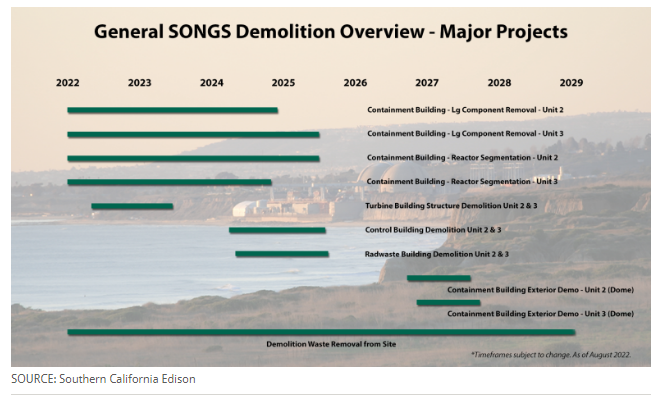As San Onofre nuclear plant comes down, bill would allow small reactors to go up
Column: Radioactive piping got mixed up with other debris. Is more nuclear in California's future?
By TERI SFORZA | tsforza@scng.com | Orange County Register
It was mid-December. The truckload of demolition debris was all loaded up and ready to depart the San Onofre Nuclear Generating Station.
But before it could be released into the wild, radiation levels had to be checked several times to ensure they weren’t above “normal background.”
The needle on the hand-held meter twitched. Radiation levels were slightly above normal background.
“Material and equipment shall not be released from radiological controls if they are contaminated with plant-related radioactive material that is distinguishable from background,” the Nuclear Regulatory Commission said in its most recent inspection report for San Onofre. “This two-step survey process was implemented, in part, to help prevent the accidental release of contaminated material.”
The truck returned to a restricted area for offloading. Workers found contaminated “radwaste discharge piping” that had been improperly marked. The remaining debris was scanned for radioactivity and cleared, while the recovered piping was “properly dispositioned as radioactive material,” the inspection report says.
The tear-down of a nuclear plant is a sensitive thing, and redundant checks are built into the process. They worked exactly as they were supposed to here, the NRC said. Southern California Edison’s demolition contractor completed a “condition report” to pinpoint the causes of the error and figure out how to keep it from happening again.
As San Onofre comes down piece by piece — the reactor vessels are being sliced up, the turbine buildings demolished, the racks removed from spent fuel pools and pressure-washed to remove “gross contamination” — the nuclear industry is positioning itself as the bridge from a fossil fuel past to a renewable energy future.
It comes a bit late for San Onofre and Southern California.
Nuclear bridge
The need for a better energy transition strategy has been driven home by skyrocketing natural gas prices in California and painful monthly bills.
Nuclear energy is “absolutely critical” to addressing climate change, the U.S. Department of Energy insists, and the NRC recently gave the thumbs up to a small modular reactor (SMR) design that has many in the industry excited for the “nuclear renaissance” that always seems just around the corner, but never quite arrives.
Why? Partly because many states ban the construction of new nuclear plants — including California, which says “no new nukes!” until the feds figure out where to put all that radioactive waste. Millions of pounds of spent fuel will remain on San Onofre’s bluff, entombed in concrete and steel, long after the last pieces of its reactors are carted away.
But, as Diablo Canyon gets a life extension to help bridge this nettlesome energy transition (it’s the Golden State’s only operating nuclear power plant), California may join the states that are reconsidering.
Bills to allow new nuclear construction have been introduced all over the country, including in West Virginia, Connecticut, Oregon, Minnesota and Illinois. Here in California, Assembly Bill 65 would exempt small modular reactors from the state’s ban.
Folks in Orange County are inclined to agree. Fifty-seven percent of residents said we should revisit nuclear energy in the last Orange County Annual Survey out of Chapman University — but, of course, they don’t want those nuclear plants near their homes.
Small is beautiful?
“Under existing law, it is the policy of the state that eligible renewable energy resources and zero-carbon resources supply 100% of all retail sales of electricity to California end-use customers and 100% of electricity procured to serve all state agencies by December 31, 2045,” says the Legislative Counsel’s digest of the bill.
If the state is to meet its ambitions goal, California must step up its game, a fact sheet on AB 65 says.
“Currently, California has a reliance upon imported energy production. In fact, California imports more electricity than any other state – about 30%, much of which is generated from harmful and unsustainable sources, such as coal-fired plants….
“To address these challenges, AB 65 would both expand the current energy portfolio by authorizing the development of SMRs within California, as well as require the Public Utilities Commission to adopt a plan to increase the procurement of electricity generated from nuclear facilities and to phase out the procurement of electricity generated from natural gas facilities.”
Small modular reactors offer advantages over conventional nuclear reactors and fossil fuel plants, it asserts: They have a smaller physical footprint, allow for greater flexibility in energy production, are cheaper and have enhanced safety and security designs. The PUC would have to adopt a plan to get more electricity from nuclear, and to phase out the procurement of electricity from natural gas, on or before Jan. 1, 2026.
Similar legislation was introduced in 2008, and 2019, and 2022. It never got far. This bill — by Assemblymember Devon Mathis, R-Porterville — is in committee. We aren’t holding our breath. But after $300 and $400 gas bills, Californians might be willing to take a look at next-generation nuclear.
Add to this the DOE’s renewed push to find temporary sites to store nuclear waste — it has set aside $26 million to help communities learn more about “consent-based siting” and management of spent nuclear fuel while it figures out the long-term solutions (which will have to involve deep geologic burial) — as well as a worldwide flirt with the possibility of clean fusion energy, and we find ourselves firmly in the 21st century.
So last century
Meanwhile, the 20th-century technology that created San Onofre continues to disappear.
“While the decommissioning work may not be visible to passersby, for us at the plant, the site changes weekly,” said a recent update by Edison Vice President and Chief Nuclear Officer Doug Bauder.
To wit: More than half of the buildings on site — 33 of 62 — have been demolished. More than 144 million pounds of waste has been shipped off-site. Cooling water intake systems have been isolated, drained and cleaned out. Racks have been removed from the Unit 2 spent fuel pool.
Once all the racks are removed from that pool, work will start on the racks from the Unit 3 pool, according to the NRC. Then the remaining water from the two pools will be drained, processed “and released in accordance with the Offsite Dose Calculation Manual.”
Meanwhile, the contractor doing the demo work will do a better job of clearly marking potentially contaminated pieces and parts, said Edison spokesman Dave Eisenhauer. The piping had been identified as potentially contaminated, but could have been better marked, he said.
The marking color for radioactive and potentially radioactive pieces: Magenta.
Striking color or no, it would be hard for a contaminated piece to slip off-site unnoticed. In the initial check, a radiation tech uses a handheld monitor to sweep the truck the load. That’s when the above-background level was found in this instance, Eisenhauer said.
Trucks are also scanned as they drive through a large truck monitor, and are scanned again by a handheld monitor before leaving the site, he said. Once they arrive at recycling centers, loads are scanned again before they’re accepted.
“There are several checks, and those systems worked as intended,” he said.
But, going forward, expect more generous use of magenta.





